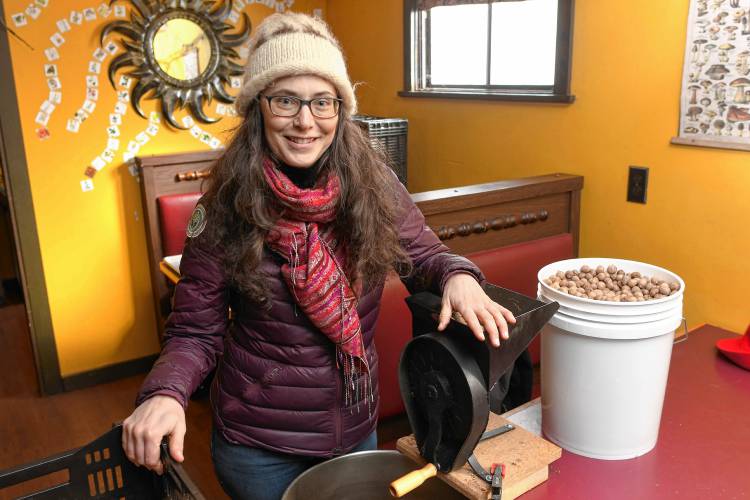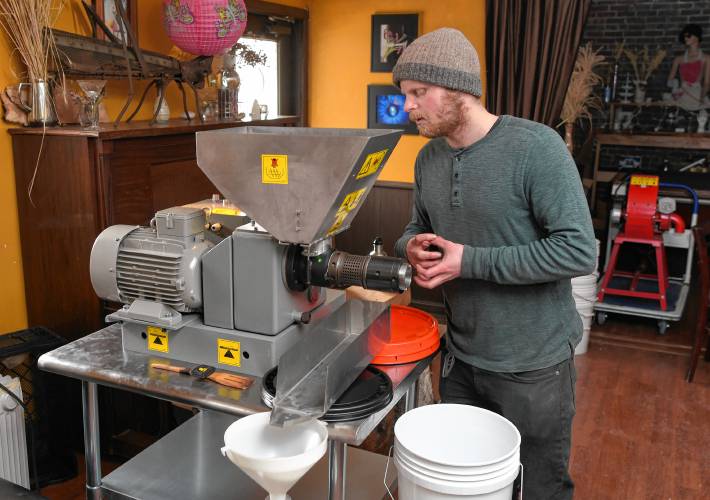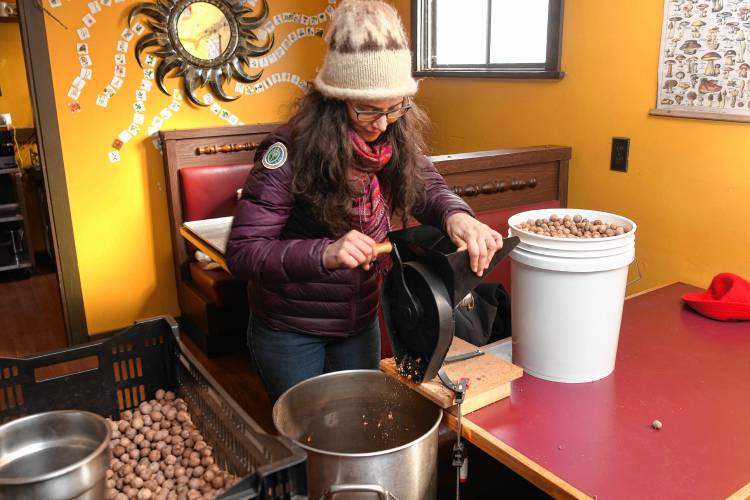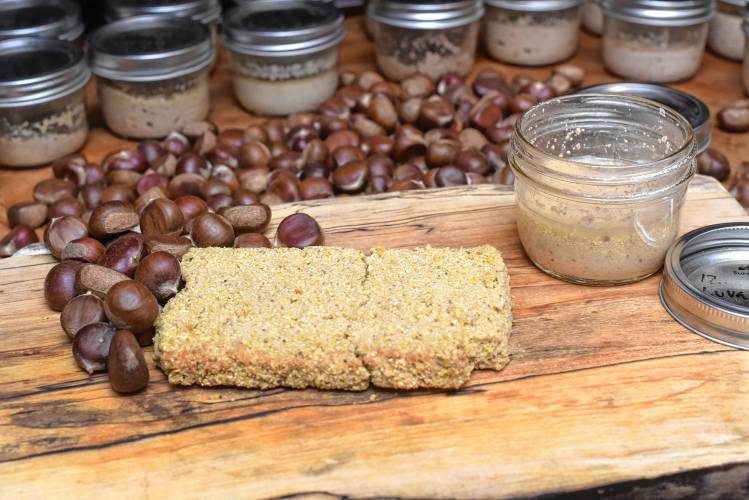Mapping the future of food: Kyra Kristof of Forest Kitchen encourages joy, play, and exploration of regenerative biodiversity
| Published: 01-30-2024 4:54 PM |
Talking about food with Kyra Kristof of Forest Kitchen was a fascinating experience.
Kristof is part artist, part social scientist, part cook, and all passion. She used terms I had never heard applied to food before.
Kristof lives with her partner and her daughter in Montague, in Lake Pleasant, “the village that I didn’t know existed until we bought a house there,” she told me recently.
“When I moved here in 2012, I had been doing work that was woven into food systems,” she recalled. As she talked to food producers locally, she said, she “began mapping latent food systems.” This entailed seeing what food producers were just on the edge of doing but didn’t quite have the knowledge to accomplish fully.
I asked for an example, and she cited a growing number of people in western Massachusetts a few years back who were starting nut orchards.
Nuts are a crop that don’t have to be replanted every year and that don’t require tilled fields for growth. They regenerate soil and are suited to hills like the ones we have in abundance in our area.
Despite these advantages, explained Kristof, for a long time nut farmers didn’t have the equipment necessary to process their nuts, to make oils or butters or anything in large quantities.
“Who would design the equipment that didn’t exist yet?” she remembered wondering.
Article continues after...
Yesterday's Most Read Articles
In conjunction with CISA, our “local heroes” agriculture organization, and with funding from various sources, Kristof began to explore local food that was mostly indigenous to the landscape.
Forest Kitchen, her current project, is a nine-year-long endeavor that began at the fall equinox in 2021 and will end on that same date in 2030 with what Kristof termed “a mass biodiverse feasting.”
She calls Forest Kitchen an art project rather than a food project. “There’s a difference in people coming to meetings versus participatory art experiences,” she stated. “We’re inviting people into a context for creativity.”
Through a variety of measures, including cooking classes, Forest Kitchen explores plants that aren’t necessarily familiar kitchen friends to most of us. “But they make sense,” she argued. “We’re engaging them in a way that encourages joy and play.”
Forest Kitchen partners with chefs and with local food producers like Stoneman Brewery to make use of some of the biodiverse plants it identifies.
“As we travel throughout the arc of each year, we are constantly in dialogue with place,” Kristof explained. “We want to create and maintain a very large pantry of forest ingredients so that people can have the experience of gathering them and feasting upon that which has been cooked.” The experience involves testing, research and storytelling.
One of the reasons for the nine-year range of the project is that each new ingredient Kristof and Forest Kitchen explore needs to be figured out in both culinary and practical terms. She asks what flavors it has and works with, and what tools are needed to gather it.
When I spoke with her, she was busy pressing nut oils. She was also working on creating nut vinegars and nut yogurts.
She recently concluded a residency at Great Falls Harvest Restaurant in Turners Falls and often returns there. She used the Great Falls Harvest kitchen to press nut oils last week — and to make the recipe below.
Forest Kitchen frequently hosts events for people interested in exploring and playing with its regenerative food palate. To be notified of upcoming events, sign up at Kristof’s website, www.forestkitchen.art .
The flatbread recipe Kyra Kristof made for this newspaper uses chestnut flour, a natural gluten-free flour she describes as highly nutritious.
She and her collaborators at Yellowbud Farm, the Northern Nut Growers Association, and Empire Chestnuts recently used the recipe to taste the differences among 33 (!) different chestnut flours.
“Different trees generate nuts with widely varying flavors. The temperature at which the chestnuts are dried, whether or not they are roasted, and how finely they are ground also affect the flavor they bring to baking, and the bubblings of fermentation,” said Kristof.
“This bake highlights the natural sweetness of chestnuts, and has a texture akin to a dense cornbread. Longer fermentation will result in a lighter and less sweet bake, and invite in other flavors.”
According to Kristof, chestnut flour will become available in our region over the next decade as recently planted trees mature. Meanwhile, she said, Ohio chestnut flour may be purchased locally through Forestopia (forestopia.org ).
Local hickory nut oil pressing for 2024, she added, is just beginning. This oil will soon be available from Northern Forest Foods (northernforestfoods.com).
Kristof noted that the bread recipe can be made as is, or can be fermented.
She prefers the latter method. To ferment, combine the chestnut flour with the water in a bowl.
Cover the bowl with a dishtowel, and let it sit “for a while … an hour, maybe two or three of four,” she explained.
“Smell periodically to see what your nose can tell you about the fermentation naturally occurring. Over time, you may need to add a few spoonfuls of additional water to thin the batter to its original consistency,” she said.
“When you feel ready, mix the remaining ingredients in another bowl, and stir them into the fermenting chestnut batter. Pour onto the prepared sheet, and bake [as described below].”
Even if one doesn’t have a lot of time to ferment the chestnut flour, Kristof suggests mixing the recipe together and letting it stand at room temperature for a little while — perhaps as long as it takes to preheat the oven. Even in that short period of time, tiny bubbles can form in the bread.
Ingredients:
2 cups chestnut flour
1/2 teaspoon salt
2 eggs (smaller duck or larger chicken eggs)
1 cup water
6 tablespoons hickory nut oil (or melted butter or olive oil if you have no hickory nut oil)
Instructions:
Preheat the oven to 375 degrees. Line a cookie sheet with parchment paper.
Mix the chestnut flour and the salt in one bowl. Beat the eggs with the water and the oil in another bowl. Combine the two bowls and blend. (If you are using melted butter, add it after all the other ingredients have been combined.)
Pour the batter onto the prepared cookie sheet, and spread it into your preferred shape at a thickness of 1/2 to 3/4 inch. Bake until the bread is golden and crisping around the edges, approximately 25 minutes.
Makes 1 loaf.
Tinky Weisblat is an award-winning cookbook author and singer known as the Diva of Deliciousness. Visit her website, TinkyCooks.com.





 Speaking of Nature: Indulging in eye candy: Finally, after such a long wait, it’s beginning to look like spring is here
Speaking of Nature: Indulging in eye candy: Finally, after such a long wait, it’s beginning to look like spring is here Celebrating ‘Seasonings’: New book by veteran preacher and poet, Allen ‘Mick’ Comstock
Celebrating ‘Seasonings’: New book by veteran preacher and poet, Allen ‘Mick’ Comstock Faith Matters: How to still the muddy waters of overthinking: Clarity, peace and God can be found in the quiet spaces
Faith Matters: How to still the muddy waters of overthinking: Clarity, peace and God can be found in the quiet spaces A time for every purpose under heaven: Free sing-a-long Pete Seeger Fest returns to Ashfield, April 6
A time for every purpose under heaven: Free sing-a-long Pete Seeger Fest returns to Ashfield, April 6
